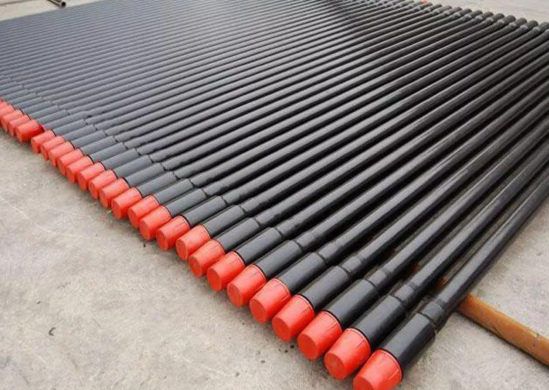The choice of drill pipe length directly impacts drilling efficiency, equipment compatibility, and operating costs. The following is a length selection strategy that comprehensively considers technical requirements and economic benefits:
API Drill Pipe Length Classification:
According to the latest version of the American Petroleum Institute (API Spec 5DP), standard drill pipe lengths are divided into three series:
1. R1 Series (Single Length): 18-22 feet (5.49-6.71 meters). Primarily used for shallow onshore wells, workover rigs, and other space-constrained operations, it facilitates manual handling and allows for quick connection.
2. R2 Series (Double Length): 27-31 feet (8.23-9.45 meters). Suitable for medium-sized drilling rigs, it balances efficiency and operability. It is used in conventional land drilling and accounts for 80% of global usage.
3. R3 Series (Triple Length): 38-45 feet (11.58-13.72 meters). Commonly used on deepwater drilling platforms, it reduces the number of connections and improves efficiency.
Note: 1 foot = 0.3048 meters. Actual procurement must adhere to API SPEC 7-1 standards with precise tolerances (typically ±0.3 meters).

Non-standard Lengths and Special Applications:
1. Customized Extra-Long Drill Pipe (46-60 feet): For example, the 13.5-meter (44.3-foot) one-piece drill pipe used in shale gas development can reduce downhole vibration.
2.
Pup Joints Design: Short drill pipes of 2-4 meters are used for directional drilling corrections. They must conform to
API thread standards but offer flexible length adjustments.
Key Factors Influencing Length Selection:
1. Drilling Depth
Shallow Wells (<3000 meters): Range 1 or Range 2, with lower stand height requirements.
Deep Wells (>5000 meters): Range 3 is recommended for deep wells to reduce time costs, but must be compatible with the drilling rig's lifting capacity. Ultra-deep wells: Use extra-long single pipes 14m+ (requires hydraulic elevators).
2. Transportation Conditions: For onshore operations, truck length limits make R1/R2 more economical; for offshore platforms, R3 is preferred.
3. Thread Wear: Frequent connections accelerate wear; longer drill pipe can extend overall life by approximately 15%.
4. Economic Analysis
Range 2: Lowest overall cost (ample inventory and convenient transportation).
Range 3: Although the price per pipe is 5-8% higher, the saved drilling time can reduce total costs by 10%+.
Extra-long single pipes: Recommended only for continuous batch drilling projects, such as shale gas platform wells.
Adjustments for Special Working Conditions:
1. Horizontal/Extended Reach Wells
Range 3 is preferred to reduce frictional fluctuations caused by connection points.
Use a top drive system to achieve rotary drilling of long single pipes.
2. Sour Environments
Reduce single pipe length, such as replacing Range 3 with Range 2. Reduce threaded connection points to mitigate H₂S corrosion risk.
3. Polar Drilling
Use Range 1 for faster operation in -40°C environments.
Shortening the stand height enhances derrick stability.
Drill Pipe Length Selection Recommendations:
Conventional Land Drilling: 9.5m (Range 2) is preferred, balancing efficiency and cost.
Deepwater/Ultra-Deep Wells: Use 13.7m (Range 3) to reduce non-productive time.
Automation Project: Piloting 15m ultra-long single pipes with intelligent drilling rigs.
Corrosive Environments: Shorten single pipe lengths to reduce connection point risks.
Industry Trends and Future Directions:
1. Lightweight Long Drill Pipe: Titanium alloys, for example, reduce the weight of the R3 series by 30%, breaking the limitations of traditional steel.
2. Automated Adaptation: Intelligent drilling rigs are driving the 12-15m standard as the new trend, reducing manual intervention.
Conclusion:
In actual use, drill pipe length needs to be adjusted based on drilling depth, geological conditions, and operational requirements. Some types can be customized. Accurate drill pipe length selection can increase drilling efficiency by up to 20% while reducing tool wear.
Read more: API 5DP Drill Pipe Specification or Casing Pipe vs. Drill Pipe


